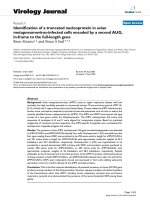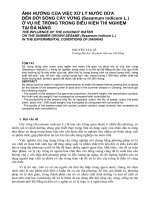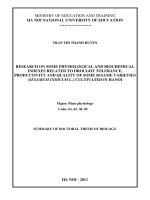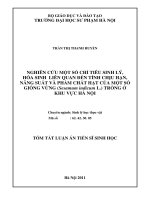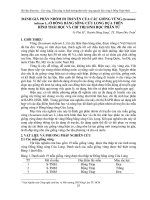Identification of climate resilient sesame (Sesamum indicum L.) genotypes suitable for southern region of A. P, india
Bạn đang xem bản rút gọn của tài liệu. Xem và tải ngay bản đầy đủ của tài liệu tại đây (239.39 KB, 5 trang )
Int.J.Curr.Microbiol.App.Sci (2020) 9(8): 1497-1501
International Journal of Current Microbiology and Applied Sciences
ISSN: 2319-7706 Volume 9 Number 8 (2020)
Journal homepage:
Original Research Article
/>
Identification of Climate Resilient Sesame (Sesamum indicum L.) Genotypes
Suitable for Southern Region of A. P, India
N. Sabitha*
Regional Agricultural Research Station, Tirupathi, India
*Corresponding author
ABSTRACT
Keywords
Sesame,
Multilocation trial,
Seed yield
components
Article Info
Accepted:
15 July 2020
Available Online:
10 August 2020
A study involving eight sesame genotypes conducted during 2018-2019 at the Regional
Agricultural Research Station, Tirupathi with an objective of identifying climate resilient
Sesame genotypes suitable for both Kharif and rabi seasons in southern region of Andhra
Pradesh indicated the existence of differential response of genotypes for seed yield and
yield components except for number of branches pert plant in both the seasons. Combined
analysis also revealed that the genotypes differed significantly for all the characters except
for branches per plant. The component of variation due to seasons was significant for all
the characters except for days to maturity and thousand seed weight. The genotype x
seasons interaction was non significant for number of branches per plant indicating the less
influence of environment on the expression of the character. Among the sesame genotypes
studied YLM 136 was found to be early in flowering and maturity. Plant height was more
in rabi season compared to Kharif. Similar trend was recorded for number of capsules per
plant. The genotypes viz., YLM 136 and YLM 139 have recorded more number of
capsules per plant in both the seasons. All the genotypes recorded higher mean values for
Specific Chlorophyll meter readings over the check YLM 66 in both the seasons. Hundred
seed weight was found higher in rabi season compared to Kharif. Three genotypes viz.,
YLM 136, YLM 142 AND YLM 147 have registered higher mean values for seed weight
over the seasons. Mean seed yield was found to be higher in rabi over Kharif season. All
the genotypes have recorded higher seed yield over the check YLM 66 in Kharif while
YLM 136, YLM 142, YLM 146 and YLM 147 registered higher seed yield during rabi
over YLM66 .Based on seed yield and yield components and two seasons YLM 136 and
YLM 142 were found to be superior to the check YLM 66 for seed yield. Theses
genotypes may be recommended for commercial cultivation in Southern region of Andhra
Pradesh after extensive testing under on – farm testing / adaptive minikit testing.
Introduction
Sesame (Sesamum indicum L.) is one of the
important oilseed crops after groundnut. Its
oil contains an oxidant called Sesmol which
imparts longer shelf life. Sesame is also rich
in phosphorous, iron, magnesium, manganese,
zinc, and vitamin B1 (Anilakumar et al.,
2010). It is grown primarily in west Godavari,
Srikakulam, Vizianagaram, Visakhapatnam,
Prakasam, Kadapa and Chittoor districts of
A.P. (Directorate of Economics & Statistics,
1497
Int.J.Curr.Microbiol.App.Sci (2020) 9(8): 1497-1501
Govt. of A.P., 2018). It is cultivated in all the
three seasons viz; Kharif, Rabi and Summer
seasons but mostly in Kharif season as rainfed
crop and in rabi and summer it is raised under
irrigated conditions. However, sesame crop
yields are low (269 kg/ha) in the state
compared to the national average yields.
Moisture
stress,
Phyllody,
Alternaria
leafspots, non-availability of improved
varieties with high seed yield, oil content and
non pod shattering nature are the major
constraints in sesame cultivation in the state.
The present investigation involving advanced
sesame genotypes of Sesame was carried out
to identify location specific high yielding
genotypes with desirable agronomic and
economic characters suitable for the light
soils of Southern region of Andhra Pradesh.
Materials and Methods
Multilocation trial with eight sesame
genotypes including one check (YLM 66) was
conducted at Regional Agricultural Research
Station, Tirupati during Kharif & rabi, 20182019 seasons The experiment was laid out in
a Randomized block design with three
replications. Experiment each genotype was
raised in ten rows of four meter length
adopting 30x10cm spacing. Recommended
dose of fertilizers @ 40:20:20 kg NPK/ha was
applied as basal at the time of sowing.
Cultural practices and crop protection
measures were adopted as per the
recommendations of ZREAC for the Southern
Zone of A.P. Data were collected on days to
50% flowering (DF), days to maturity (DM),
plant height (PH), No. of branches/plant
(BPP), no. of capsules/plant(CPP) and
Thousand seed weight(g) as (TSW) and seed
yield (kg/ha) during crop growth and at
harvest analysis of variance was carried out as
per the standard statistical procedures using
the OPSTAT software (O.P Sheoran). To
establish the magnitude of the variation
among cultivars, comparison of means was
made with at five per cent level of
significance (Panse and Sukhatme, 1978).
Results and Discussion
Analysis of variance for seed yield and yield
components in Kharif and rabi seasons
revealed the existence of variation among the
genotypes for days to 50 per cent flowering,
days to maturity, plant height, number of
capsules per plant, SPAD meter readings,
thousand seed weight and seed yield except
for number of branches per plant during
Kharif, 2018. Mean sum of squares were
significant among the genotypes for days to
maturity, plant height, number of capsules per
plant, SPAD meter readings, thousand seed
weight and seed yield except for days to 50%
flowering and number of branches per plant
during rabi. Combined analysis also revealed
that the genotypes differed significantly for
all the characters except for branches per
plant. Similar results were also reported by
Bharathi et al., (2014) and Baraki et al.,
(2016).
The component of variation due to seasons
was significant for all the characters except
for days to maturity and hundred seed weight.
The genotype x seasons interaction was non
significant for number of branches per plant
indicating the less influence of environment
on the expression of the character (Table 1).
Performance of the sesame genotypes for seed
yield and yield contributing characters is
furnished in Table 2. Among the genotypes
YLM 136 was found to be early in flowering
(35days)and maturity (78days) compared to
the check YLM 66 (44 and 86 days) in Kharif
while YLM 146 was noted for early flowering
(42 and 75.30 days) and maturity in rabi
season. Plant height was found to be low in
among the sesame genotypes during Kharif,
2018(76.7cm) compared to rabi 2018-19 (109
cm).
1498
Int.J.Curr.Microbiol.App.Sci (2020) 9(8): 1497-1501
Table.1 Combined analysis for seed yield and yield contributing characters of sesame (2018-2019)
Source of Variation
Replications
df
1
DF
3.083
DM
4.95
PH(cm)
5.92
BPP
0.667
CPP
2.23
Genotypes
7
9.89 **
56.94**
42.84**
1.164
239**
Seasons
1
130.02*
1.33
Seasons x Genotypes
7
14.4**
26.57**
32.81**
0.62
Pooled Error
28
1.2
4.64
4.48
0.524
SPAD
1.41
TW(g)
0.07
Seed yield(kg/ha)
6.17
143.558** 0.39**
44833.45**
324.91**
0.02
147232.13**
45.32**
33.05**
0.06**
18521.61**
2.71
0.95
0.01
4.41
12393.8** 25.521** 15624.1**
*Significant at 5 per cent level of probability
** Significant at 1 per cent level of probability
Table.2 Performance of sesame genotypes for seed yield and yield components in Kharif and rabi seasons (2018-2019)
Genotype/
season
YLM 136
YLM 139
YLM 141
YLM 142
YLM 143
YLM 146
YLM 147
YLM 66
GM
CD
CV %
DF
Kharif
35
37
38
39
41
40
38
44
39
1.81
2.63
Rabi
42
43
42
41
43
42
42
41
42
NS
3.2
DM
Mean
39
40
40
40
42
41
40
43
41
NS
1.89
Kharif
78
84
78
81
86
80
83
86
82
1.12
0.77
Rabi
82
77
85
81.3
86
75.3
83.3
86
82
5.31
3.66
Plant height(cm)
Mean
80
81
82
81
86
78
83
86
82
0.98
2.10
1499
Kharif
77
78.1
77.7
77.3
76.3
73.9
74.6
78.5
76.7
2.15
4.95
Rabi
101.3
114.3
110.2
114.7
111.7
109.3
103.7
106.7
109.0
3.96
7.67
Mean
89.2
96.2
94.0
96.0
94.0
91.6
89.1
92.6
92.8
2.89
4.10
No. of Branches/
plant (BPP)
Kharif Rabi Mean
3
5
4
4
5
4
4
6
5
4
5
4
3
5
4
3
4
4
3
5
4
3
5
4
3
5
4
NS
NS
NS
2.52
3.60 2.95
Int.J.Curr.Microbiol.App.Sci (2020) 9(8): 1497-1501
Contd…Table.2
Genotype /
season
YLM 136
YLM 139
YLM 141
YLM 142
YLM 143
YLM 146
YLM 147
YLM 66
GM
CD
CV %
No. of Capsules/ plant
(CPP)
Kharif Rabi Mean
62
89
76
53
92
73
53
85
69
54
84
69
46
87
67
35
76
56
45
80
62
42
85
64
49
85
67
3.53
4.16
3.96
6.41 10.46 9.20
SPAD
Kharif
62.8
66.2
60.4
64.4
54.6
54.2
57.2
50.7
58.8
2.2
4.3
Test weight (g)
Rabi
47.8
60.8
54.6
60.6
52.4
55.7
50.6
46.5
53.6
2.08
4.7
Mean
55.3
63.5
57.5
62.5
53.5
55.0
53.9
48.6
56.2
3.20
5.10
However the differences among the genotypes
for plant height were significant in both the
seasons. Among the genotypes YLM 139
(78.10 and 114.3cm) and YLM 142 (77.3 and
114 7cm) recorded higher plant height in both
the seasons. Less variation was noted among
the genotypes for number of branches per
plant in both the seasons but number of
branches per plant were more in rabi (5)
compared to Kharif (3). The genotype YLM
141 registered more branches per plant in
both the seasons. Similar trend was recorded
for number of capsules per plant during
Kharif and rabi. Seasonal variation of seed
yields were recorded by Ahmed and Ahmed
(2010). More number of capsules per plant
were noted in rabi (85) over Kharif (49). The
genotypes viz; YLM 136 and YLM 139 were
found significantly superior to the check
YLM 66 for capsules per plant over the
seasons while YLM 141 and YLM 142 in
Kharif and YLM 143in rabi recorded more
number of capsules per plant.
Specific chlorophyll meter readings among
the genotypes were found to be high during
Kharif (58.80) compared to rabi (53.6)
seasons. All the sesame genotypes have
Kharif
2.8
2.4
2.3
2.9
2.2
2.4
3.0
2.5
2.6
0.17
5.4
Rabi
3.0
2.5
2.4
2.7
2.3
2.2
2.7
2.3
2.8
0.16
5.2
Mean
2.9
2.5
2.4
2.8
2.3
2.3
2.9
2.4
2.7
0. 19
4.80
Seed yield (kg/ha)
Kharif
631
499.8
462.3
780.9
393.6
562.3
568.5
337.4
529.5
87.06
9.20
Rabi Mean
647.8 639.4
617.8 558.8
581.8 522.1
713.2 747.1
623.2 508.4
666.8 614.6
648.3 608.4
622.2 479.8
640.1 584.8
19.47 30.20
6.56
8.57
recorded higher SPAD values over the check
YLM 66 in both the seasons. Among the
genotypes YLM 139 (63.5) and YLM 142
(62.5) registered significantly higher values
for SPAD meter reading over seasons
compared to YLM 66 (48.6). Mean thousand
seed weight was found high in rabi (2.8g)
compared to Kharif (2.6 gm) season.
However, the genotypic variation was noted
for seed weight in both the seasons. YLM
136, YLM 142 and YLM 147 registered
significantly higher seed weight over the
check YLM 66 and over two seasons.
Hundred seed weight was found higher in rabi
season compared to Kharif.
The genotypes differed significantly for seed
yield in Kharif and rabi seasons. However,
mean seed yield was found to be higher in
rabi (640.10kg/ha) over Kharif (529.50kg
/ha). Wide variation for seed yield in sesame
was also reported by Chandra Mohan (2011).
All the genotypes have recorded higher seed
yield over the check YLM 66 (337.4 kg/ha) in
Kharif while YLM 136, YLM 142, YLM 146
and YLM 147 registered higher seed yield
during rabi over YLM66 (622.2 kg/ha) .
Among
the
genotypes
YLM
142
1500
Int.J.Curr.Microbiol.App.Sci (2020) 9(8): 1497-1501
(747.10kg/ha), YLM 136 (639.40 kg/ha),
YLM 146 (614.60kg /ha) and YLM 147
(608.4kg/ha) recoded significantly higher
seed yield compared to the check YLM 66
(479.8 kg/ha) over two seasons.
In conclusions based on the performance of
the sesame genotypes over two seasons for
seed yield and yield contributing characters it
is concluded that YLM 136 and YLM 142
may be recommended for commercial
cultivation after thorough testing under onfarm trials and adaptive minikit testing.
References
Agricultural Statistics at a Glance - Andhra
Pradesh.
2018.
Publication
by
Directorate of Economics & Statistics,
Govt. of Andhra Pradesh. pp: 25-26
Ahmed, M. B. S. and F. A. Ahmed,2010.
“Genotype × season interaction and
characters association of some Sesame
(Sesamum indicum L.) genotypes under
rain-fed conditions of Sudan,” African
Journal of Plant Science, vol. 6, no. 1,
pp. 39–42, 2012.
Anilakumar R. K., A. Pal, F. Khanum and A.
S. Bawa, 2010. Nutritional, medicinal
and industrial uses of sesame
(Sesamum
indicum
L.)
seeds,
Agriculturae Conspectus Scientificus,
vol. 75(4
Baraki, F. Y. Tsehaye, and F. Abay, 2016.
Analysis of genotype × environment
interaction and seed yield stability of
sesame in Northern Ethiopia. Journal
of Plant Breeding and Crop Science,
vol. 8, no. 11, pp. 240–249, 2016.
Bharathi, D; Thirumalaao, V; Chandramohan,
Y; Bhadru, D and Venkanna. V. 2014.
Genetic variability studies in Sesame
(Sesamum indicum L). International
Journal of Applied Biology and
Pharmaceutical Technology. (4): 3133.
Chandra Mohan, Y. 2011. Genetic variability,
Genetic advance and character
association in Sesame (Sesamum
indicum L.). Crop Research. 42(10):
259-262.
Panse, V.G. and Sukhatme 1978. Statistical
methods for Agricultural Workers.
ICAR, New Delhi Publication.
Sheoran, O.P Hisar statistical package for
Agricultural scientists (OPSTAT),
CCSHAU.http://www.202.141.47.5/op
stat/index.asp.
How to cite this article:
Sabitha, N. 2020. Identification of Climate Resilient Sesame (Sesamum indicum L.) Genotypes
Suitable for Southern Region of A. P, India. Int.J.Curr.Microbiol.App.Sci. 9(08): 1497-1501.
doi: />
1501




